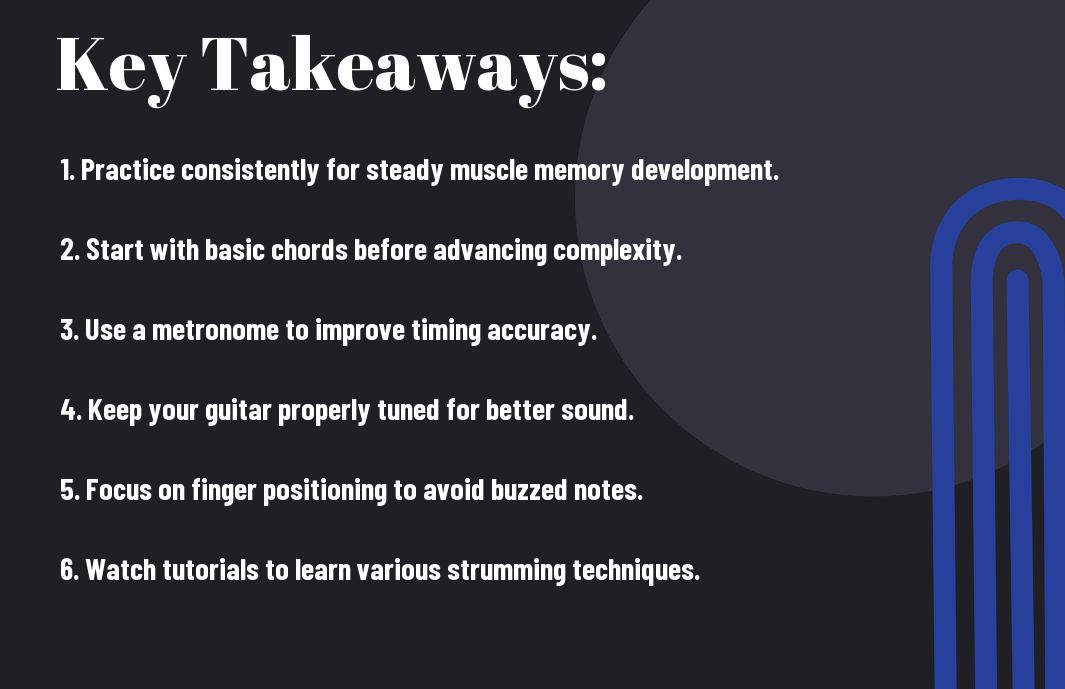Just when you think picking up the guitar might be overwhelming, I’m here to simplify the journey for you. As a fellow enthusiast, I understand how daunting it can feel to start your musical adventure. In this post, I’ll share some necessary tips that can help you build a solid foundation, improve your technique, and keep your motivation high. From choosing the right guitar to maintaining good practice habits, these insights will steer you in the right direction towards becoming a skilled player while ensuring you enjoy every moment of your learning experience.

Essential Gear Choices that Affect Your Learning Curve
Your choice of gear can significantly influence how quickly you pick up the guitar. Investing in the right instruments and accessories not only enhances your playing experience but also keeps you motivated to practice regularly. By making informed choices from the start, you can ease your learning process and enjoy the journey of mastering the guitar.
Selecting the Right Guitar for Beginners
The first step in your guitar journey is selecting the right instrument. For beginners, I recommend starting with an acoustic guitar due to its simplicity and versatility. Look for one with a comfortable neck profile and a body size that feels right for you. Brands like Yamaha and Fender offer excellent beginner models that are both affordable and easy to play.
Must-Have Accessories for Your First Months
To complement your guitar, acquiring crucial accessories can greatly enhance your learning experience. Essentials include a sturdy guitar tuner, a reliable capo, and a selection of picks, which will help you explore different styles and techniques with ease.
Having these accessories not only supports your ability to tune your guitar quickly but also allows you to experiment with various sounds and playing techniques. A guitar tuner ensures your instrument is always in pitch, which is vital as an out-of-tune guitar can lead to frustration. A capo can expand your range of chords and make playing along with your favorite songs much easier, while picks can help you develop your strumming patterns. Investing in a decent guitar strap also allows you to play comfortably while standing, providing you with the freedom to move and enjoy yourself while practicing. Overall, these accessories make your learning process smoother and more enjoyable as you develop your skills.
Building a Solid Foundation with Daily Practice
To truly progress as a guitarist, establishing a daily practice routine is crucial. Consistency breeds familiarity with your instrument, enhancing muscle memory and developing your overall skill set. I’ve observed that even 15 to 30 minutes a day can make a significant difference. This daily commitment to practice will help you internalize chords, scales, and techniques more effectively than sporadic, lengthy sessions.
Crafting an Effective Practice Schedule
Personalizing your practice schedule can greatly influence your growth. I suggest breaking your time into focused segments, allocating time for warm-ups, technique drills, and learning new songs. For example, you could spend ten minutes on warm-ups, twenty minutes on scales, and the remaining time applying what you’ve learned to a song. Adapting your schedule to include different styles and techniques keeps your practice engaging and improves your versatility.
The Importance of Warm-Ups and Scales
Incorporating warm-ups and scales into your routine sets the stage for productive practice sessions. They not only help prevent injury but also prepare your fingers and mind for playing. Warm-ups increase dexterity and promote fluid movements, allowing you to tackle more complex techniques confidently.
Without warm-ups, you may find yourself struggling with even simple riffs or chord transitions. I like to start with finger exercises and simple scales like the pentatonic or major scale. Doing this for just five to ten minutes a day primes your fingers for playing and reinforces your understanding of the fretboard. A steady practice of scales builds both your speed and accuracy, crucial for developing your unique playing style. Consistently combining warm-ups with scales allows you to track your progress and feel a tangible sense of improvement over time.
Recognizing and Avoiding Common Pitfalls
New guitar players often encounter various obstacles that can hinder their progress. By identifying and steering clear of these common mistakes, you can enhance your learning experience. Many players struggle with poor posture, lack of proper picking technique, and inconsistent practice routines. Addressing these issues head-on can dramatically improve your skill level and enjoyment of playing. I’ve seen countless students struggle and later succeed simply by avoiding these pitfalls, so being mindful of them can set you on the right path.
The Three Critical Mistakes Most New Players Make
First-time guitarists frequently overlook finger placement, leading to unwanted buzzing sounds and missed notes. Equally damaging is the tendency to rush through learning songs, sacrificing understanding of music theory and technique. Lastly, many beginners let frustration dictate their practice sessions, which can lead to burnout. Addressing these issues early on paves the way to a more enjoyable and productive learning experience.
How to Break Bad Habits Early
Establishing good habits from the outset can save you from a frustrating journey down the road. Start by focusing on posture and hand positioning for every practice session. Use a metronome to enforce timing, patiently work on scales, and don’t shy away from recording your practice to gain insight into areas that need improvement. The sooner you identify and tackle bad habits, the more effective your progress will be.
Recording your practice can be an eye-opening experience. Not only does it allow you to hear your progress over time, but it also highlights specific issues that might go unnoticed in real-time. By focusing on small sections of songs or exercises, I’ve found that breaking down complex techniques into manageable pieces prevents overwhelm and fosters better muscle memory. Seeking feedback from others or dedicated online courses can further enhance your learning curve, helping you stay motivated and on track.
Exploring Techniques that Diversify Your Skills
Diving into various techniques can significantly enhance your guitar proficiency and broaden your musical vocabulary. By experimenting with different styles and methods, you not only discover your unique sound but also strengthen your ability to tackle a wide range of songs. Techniques such as fingerpicking, hammer-ons, and slide guitar can add depth and character to your playing, making it more expressive and interesting to listen to.
Chord Variations and Progressions
Incorporating chord variations into your repertoire can transform simple songs into rich musical experiences. Rather than sticking to basic major and minor chords, experiment with seventh chords, add9 chords, or alternate voicings. Familiarizing yourself with various chord progressions can also elevate your songwriting. For instance, the I-IV-V progression is a classic choice, but don’t hesitate to mix in variations like ii-V-I for a jazzier feel.
The Role of Strumming Patterns in Song Creation
Strumming patterns serve as the heartbeat of your music, providing rhythm and character. Different patterns can evoke various emotions; a simple down-up strum may convey a relaxed vibe, while a syncopated rhythm can inject energy and excitement. I often find that manipulating strumming patterns allows me to make a song my own, turning a straightforward track into something uniquely personal.
Experimenting with various strumming techniques is a game-changer for any player. You might try syncopated strumming on a folk tune, giving it a lively bounce, or using muted strums to create a percussive effect on a rock song. Combining these patterns with different tempos can create exciting contrasts, keeping your audience engaged. As you invent these rhythms, consider how they complement your chosen chords, enhancing not only your playing but also your overall songwriting abilities. The freedom to express yourself through both strumming and chord variations can transform your guitar playing into a captivating art form.
Incorporating Music Theory for Deeper Understanding
Incorporating music theory into your practice allows for a deeper understanding of the guitar and its musical context. By grasping foundational concepts, you not only enhance your playing technique but also foster creativity. To dive deeper into the learning experience, I recommend checking out What are some tips for beginners for learning guitar?.
Understanding the Basics: Notes, Scales, and Structure
Familiarizing yourself with notes, scales, and the structure of music is paramount. Notes are the building blocks, while scales provide a framework for melodies and improvisation. I found that learning the major and minor scales equipped me with crucial tools to comprehend how songs are constructed, enabling a more meaningful connection with the music I play.
How Theory Enhances Your Playing and Creativity
Understanding music theory allows you to tap into your creativity in unprecedented ways. It empowers you to break away from the confines of standard chord progressions and explore your unique style. With basic knowledge of harmony and chord relationships, you can craft original compositions or add personal flair to the songs you cover.
Diving deeper into how theory enhances playing, I’ve noticed that recognizing chord functions—such as tonic, subdominant, and dominant—helps me transition between chords smoothly during improvisation. When I understand why a chord works within a progression, I’m able to select alternatives that create tension or release in a way that feels both intuitive and satisfying. Incorporating various scales over a chord progression enables me to experiment with melodic ideas, making my solos richer and more compelling. One of the most exciting aspects is discovering how theory gives you the confidence to express yourself, transforming mere notes into heartfelt music.
Conclusion
To wrap up, I encourage you to embrace the learning process as a new guitar player. Start by practicing regularly, focusing on basic chords and techniques, and don’t hesitate to seek guidance through online resources or local instructors. Your journey will be filled with challenges and triumphs, so be patient with yourself and celebrate small victories. With dedication and passion, you’ll see your skills flourish over time, and guitar playing will become a rewarding part of your life. Enjoy the music you create!




